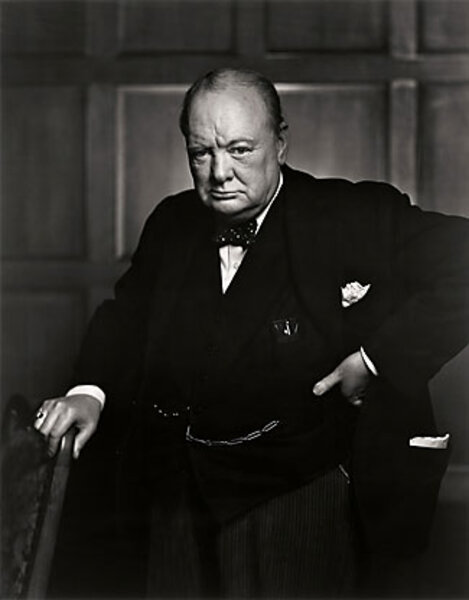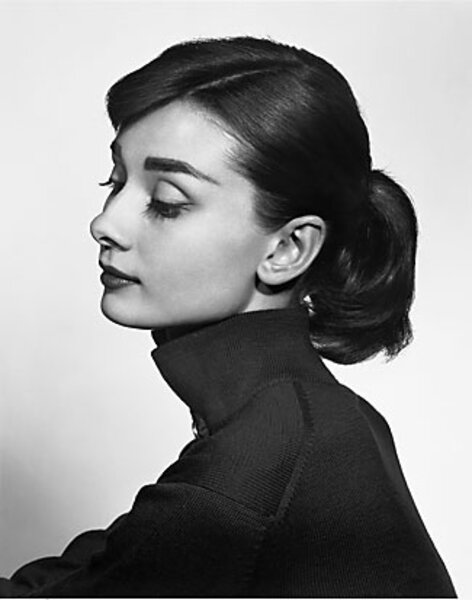Karsh’s art – iconic yet intimate
Loading...
Before there were paparazzi, there was Yousuf Karsh (1908-2002), the eminent Canadian photographer who specialized in portraits of world luminaries, or "the good, the great, and the gifted," as an Australian exhibition of his work was titled. More than 100 of his iconic, black-and-white portraits can be seen at the Museum of Fine Arts in Boston through Jan. 19 in a retrospective, "Karsh 100: A Biography in Images."
The show, which celebrates the centenary of his birth, inspires déjà vu, not just because the roster is a flashback of masters of the universe in politics, science, and the arts. Karsh's subjects like Albert Schweitzer, George Bernard Shaw, and Cary Grant hail from a vanished era, and his style, too, is like a burnished relic from the 20th century.
Today throwaway images of celebs at their daily tasks, hair askew and paunch hanging out, bombard the public. In contrast, a Karsh portrait is monumental, ready to be carved on Mt. Rushmore. He toted his 350 pounds of equipment to his subjects' studios, homes, and offices to capture them for eternity, in all their majesty.
Karsh's 1941 portrait of Winston Churchill, one of the most reproduced photos ever, launched his career. Churchill had just given a rousing speech to the Canadian parliament during the dark hours of Britain's struggle against the Nazis, but when Karsh confronted the great man for a picture, he was grumpy. After Karsh plucked the cigar out of the prime minister's mouth, Churchill glared balefully at him. The glowering image made the cover of Life magazine, and Churchill's belligerent stare became a symbol of the British people's bulldog spirit.
During a 60-year career, Karsh attempted to record, he said, "the human spirit, the human soul" of "giants of the earth." His highly detailed portraits of movers and shakers can be very moving. They also shake our conventional perceptions. In a tight close-up taken in 1971, Fidel Castro stares into the camera with steely resolve. Yet a few gray hairs in his beard and his soft mouth suggest a well-meaning idealist, the crusading revolutionary he once was.
To Estrellita Karsh, the secret of her husband's success as a person and a photographer lay in his humanity. "The level at which he met" his subjects, she said in an interview, "was primarily human." She believes Karsh's innate optimism and faith in the goodness of people brought out the best in his subjects.
His pictures, shot during both the hot and cold wars, provided hope in a difficult time. Nikita Krushchev, swathed in a fur coat and smiling benignly, seems no more capable than Santa Claus of sending nuclear missiles into Cuba. "The face of the eternal peasant, perhaps the collective portrait of a great people" is how Karsh described the portrait taken in 1963.
Karsh's absence of bitterness or cynicism is all the more surprising, given the trauma of his childhood. Born in Armenia in Turkey, he and his family suffered persecution and witnessed the massacres of 1915 before escaping to Syria in 1922. As a 17-year-old, Karsh spent 29 days in steerage on a boat to Canada, where he arrived hungry, penniless, and knowing no English. He studied the Old Master paintings of Rembrandt and Velázquez in Boston's Museum of Fine Arts to learn the arts of chiaroscuro and composition and mastered dramatic theatrical lighting when he set up shop in Ottawa, Canada.
Karsh searched for the moment when personality, character, mind, and spirit are revealed in a subject's eyes, hands, and gesture.
This quest often required cajoling. The artist Joan Miró showed up with his hair slicked back, dressed like a banker in a Savile Row suit. "Is this the way you work?" Karsh asked. "Of course not," Miró answered. "I want to photograph the artist," Karsh said, "not just someone on a Sunday afternoon."
"Slowly, slowly," Mrs. Karsh recalls, "we got the work clothes on." The portrait shows the artist holding a paintbrush, his hands spotted with paint, a mischievous smile on his lips, and a "you found me out" gleam in his eye.
His subjects often recognized the inner truth of their portraits. When Tennessee Williams was in rehab trying to kick his alcoholism, he wrote Karsh requesting his photograph. The picture, taken in 1956 when Williams was at the top of his game, shows the writer pausing at his typewriter, his brow furrowed and smoke wreathing his head as if he's burning with ideas and creativity. "I want to look at it and remember," Williams wrote, "and become that person again."
Karsh did not glamorize his famous or infamous subjects. "He was not Pollyanna-ish and not naive," Mrs. Karsh says. "He knew there were terrible people, and he had experienced terrible things." But he had the ability to "reach beneath the exterior and beneath the press hype if the person were famous or notorious and get to the person beneath."
Ernest Hemingway, photographed in Cuba in 1957 with his weather-beaten face, looks profoundly sad. Albert Einstein, his mane of hair tamed and eyes shining in a 1948 photo, seems like a gentle soul of "essential goodness," which Karsh said he felt in his presence. When Karsh asked, "To whom should we look for the hope of the future of the world?" Einstein replied, "To ourselves."
To Karsh, his subjects were heroes. Papa Hemingway might have provided a counterpoint, as in the final words of his novel "The Sun Also Rises": "Isn't it pretty to think so?"







